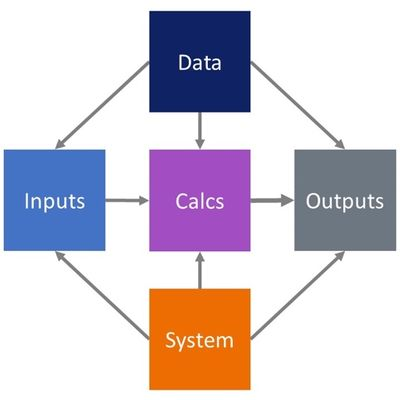
Sign up to receive latest insights & updates in technology, AI & data analytics, data science, & innovations from Polestar Analytics.
Editor's Note:� In this blog, we will explore the significance of space optimization in Anaplan and how it leads to better performance and collaboration. We will also discuss the key benefits of space optimization strategies you can use to optimize space in your EPM solution.
Businesses are effectively implementing Anaplan solutions to achieve connecting planning, but is your planning really connected? According to a report by Gartner, 56% of the time spent on strategic planning is wasted on non-planning and reporting activities.
But have you wondered why it is? Majorly, the blame goes to the sub-optimal performance that even EPM solutions like Anaplan encounter. Thus, creating a sense of unreliability and defeating the whole purpose of the platform.
This makes it essential to assess the key parameters of the application to drive reliable results within minutes. These parameters include:
Most businesses are often unaware of these parameters that are needed to put your Anaplan solution in hyperdrive and reduce overheads.
Anaplan has been enabling corporations to rev up their planning process and develop strategies that significantly bump the company's growth. However, the amount of data being processed and stored in Anaplan Solutions has been proliferating, resulting in increased costs and diminished performance due to inefficacious models.
But is there a remedy out there? Fortunately, there is! The concept of space optimization is percolating in the world of planning that can offer businesses substantial benefits.
In this blog, we will explore the significance of space optimization in Anaplan and discuss the key benefits and strategies you can use to optimize space in your EPM solution.
Suboptimal models and workspaces pose a challenge for many corporations as poorly constructed models and workspaces can consume lots and lots of space and memory, making space optimization the need of the hour.
Better application performance
Large models with extensive data can impact the performance and response time of Anaplan services. Space optimization techniques, such as data aggregation, selective data loading, and efficient formula usage, help in the performance tuning of models by reducing unnecessary calculations and optimizing ALM (Application Lifecycle Management).
Optimized models are designed to execute calculations and processes quickly, resulting in faster user response times. With optimized data storage, retrieval of information becomes quicker and more efficient.
Model Complexity
At the core of any Anaplan Implementation, the solution focuses on building intricate and detailed models to support an organization’s planning and decision-making processes.
However, as the business continues to generate data, the model becomes more complex and cannot be extrapolated because of the dynamic nature of the business environment. And so, as the complexity of these models increases, the workspace required to accommodate them also grows.
Effective space optimization ensures an optimized model blueprint that structures and organizes the entire workspace in a way that maximizes efficiency and usability.
User experience
User experience can make or break your Anaplan services. While a poorly constructed model can lead to bugs, lags, and an overall inefficient performance, well-organized and optimized models enhance the user experience within Anaplan.
But where does space optimization come into the picture?
Honestly speaking, creating a model in Anaplan is no rocket science. Anaplan's easy interface has allowed people to develop and use models with minimal hassle. But remember that models are complex, and a poorly created model can eat up unnecessary space and prove subpar in performance.
However, following the PLANS approach can be the answer to achieving high-performing models with ease. PLANS is the new standard in Anaplan modeling that encompasses the five fundamental principles or considerations that organizations should consider while designing and building models in Anaplan.
These principles help ensure the models are well-structured, efficient, and aligned with best practices. Let's explore what each element of PLANS represents in the context of Anaplan modeling.
Performance - Performance refers to optimizing model design and calculations, such as reducing repeated calculations to ensure efficient and fast processing. Performance is all about using the structures and formulas to create models for an optimized hyper block.

Image Source: Anaplan
Logical - As the name suggests, it refers to the logical flow and organization of data and calculations within the model. It focuses on creating models and formulas with a given logic and flow. The best way of creating a logical model is to follow the DISCO approach.
Simply put, DISCO is a part of the process recommended while creating model and module design. It aims to categorize modules into 5 parts.

Image source: Anaplan Community
Auditable - Auditable refers to the ability to track and review model changes and ensure data integrity. It involves implementing proper version control, data validation, and audit trails to track model changes by breaking the formula for better understanding, performance tuning, and maintainability.
Necessary - Necessary refers to the principle of keeping the model concise and focused on the essential elements required to achieve the desired outcomes. It involves avoiding unnecessary complexity and redundant calculations. Instead, it states that data should be stored and calculated once and referenced many times for efficient calculations.
Sustainable - A sustainable model is designed with flexibility in mind. It refers to the ability to ensure future scalability and evolution of the model over time. It involves building models in a way that allows for future updates, adaptability, and enhancements.
In This Webinar, We Will Showcase How Companies Can Effortlessly Manage Cashflows With Integrated Anaplan Solutions With an Exciting Demo!
Space optimization is a thing that many Anaplan users sorely need. It has been observed that efficiently created workspaces and models can work 50% better than standard modules. This massive bump in performance tuning gives extra juice to your processing power.
Space rationing is a complex endeavor encompassing various convoluted computations that refine the existing models and workspaces. Advanced optimizations are generally imparted to optimization experts that use numerous methods to deliver enhanced solutions. However, there are two reports that you can run to gauge your Anaplan platform performance.
Model Open Analysis
When the model opens, it runs through all the calculations in the model, leading to a longer load time and delayed processing. Mainly, only 1-10 line items can make up 80 to 90% of the calculation time in a model. Identifying and optimizing those line items can often have a dramatic effect on model open time.
Model open analysis helps to identify those heavy areas of the model that can take a long time to calculate. It can then set precedence to the other line items that can be calculated quickly.
Model Concurrency Testing
The primary intent of model concurrency testing is to validate that the model's key user journeys perform optimally at the expected level of simultaneous user interaction. In layman's terms, it identifies the users who are more actively involved in the model and set precedence to the user if many users are working simultaneously.
Model concurrency testing also identifies the most used areas in a model, highlighting areas that do not perform well when many users are active simultaneously.
Many Anaplan Partners offer Anaplan Consulting & Implementation. However, when it comes to space optimization, clients generally find a scarcity.
Polestar Analytics is a leading Anaplan partner for organizations across 14 countries that provide enterprise-grade space optimization services for the Anaplan platform. We have a 600+ member strong team delivering top-notch optimization solutions across planning, analytics, and integration.
Our space optimization services offer a detailed and comprehensive view of workspaces and models. Our assessments include:
We help measure the health of your Anaplan setup and your models by assessing the following parameters:
The assessment report also contains auditor comments which talk about the deviations from best practices.
Polestar Analytics is one of the early players in the market that are well equipped to optimize your Anaplan implementation. With a core knowledge of Anaplan services our team of 500+ experts possess the skills to infuse your Anaplan models and workspaces with optimized logic, seamless calculations, and cost-effective data management that can take your planning process to another level.
Struggling to carve out more space and performance from your Anaplan solution? Schedule a free consultation with us today!
About Author

Marketing Consultant
Always look for insight as to how you can better structure data within your business, there's surely a nugget of wisdom out there for you